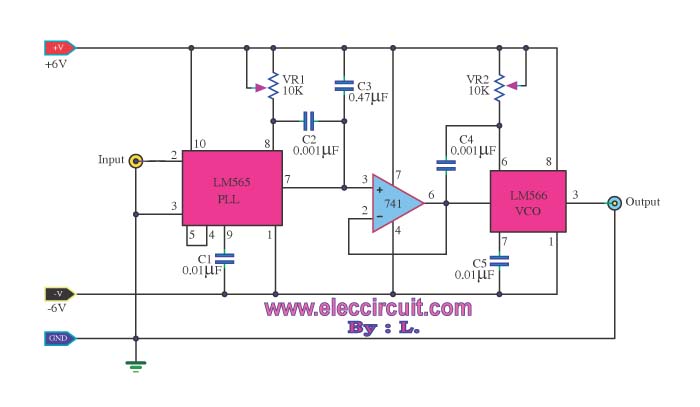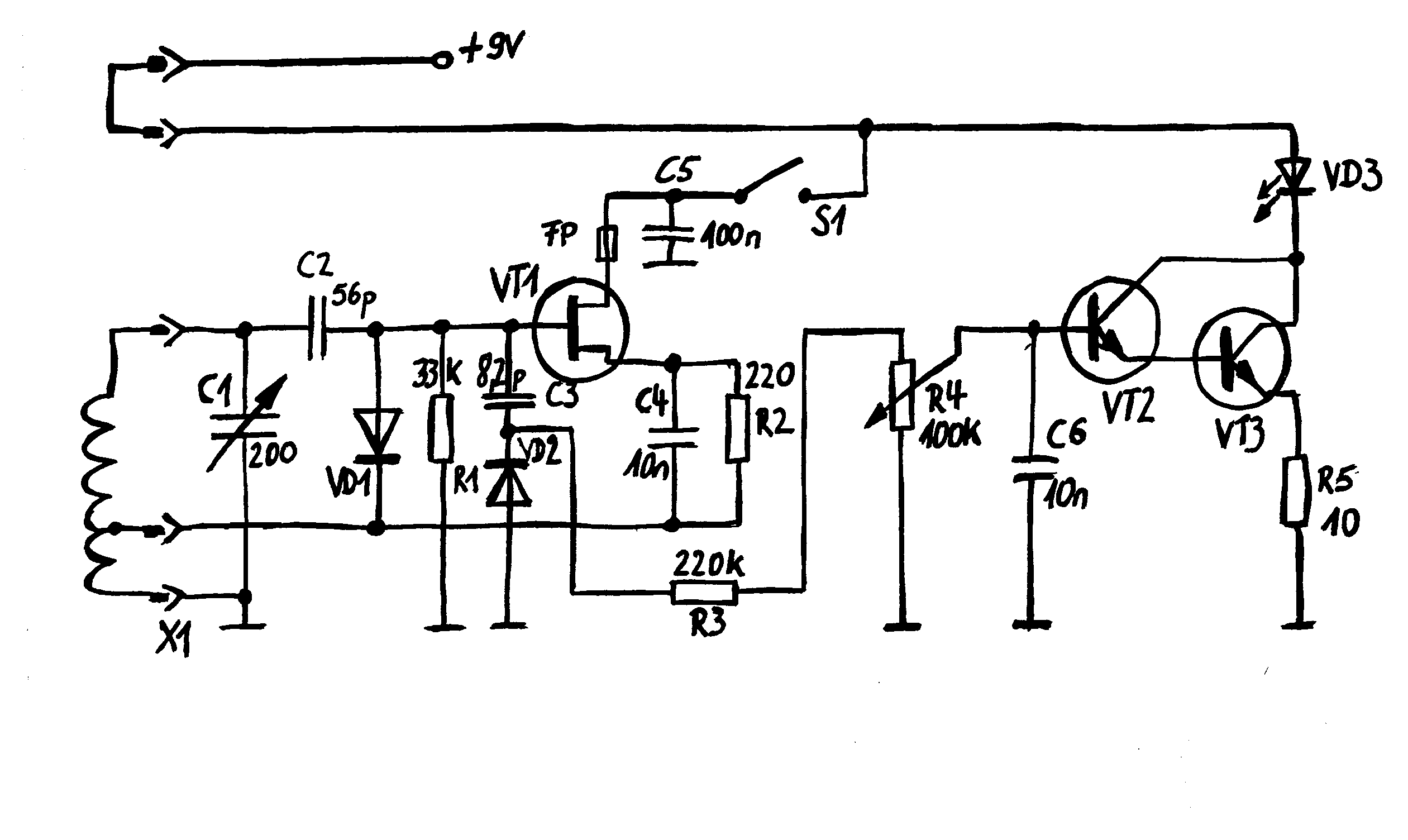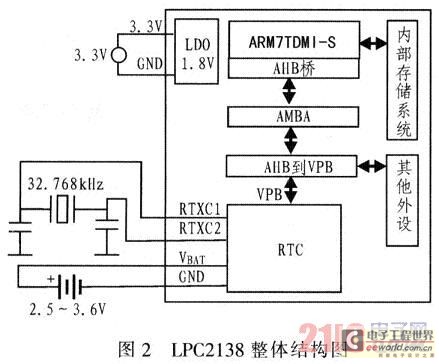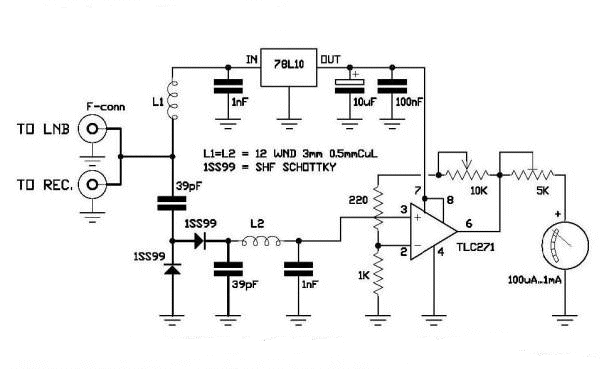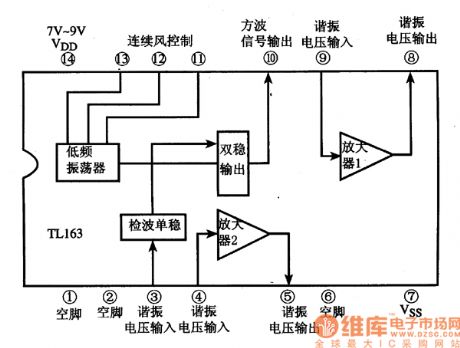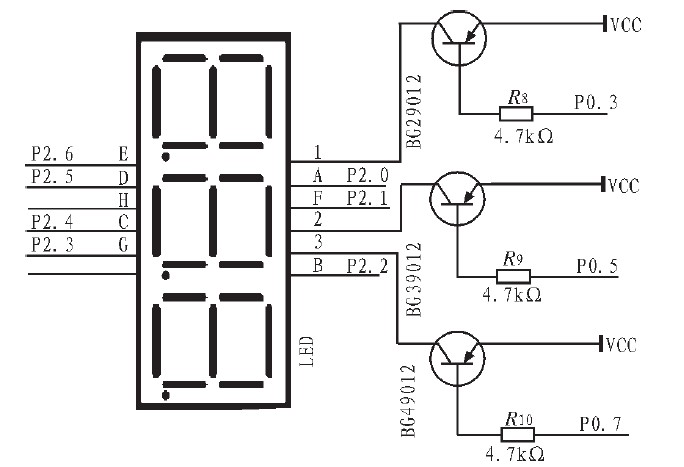
Sonic depth finder of the amateur fisher
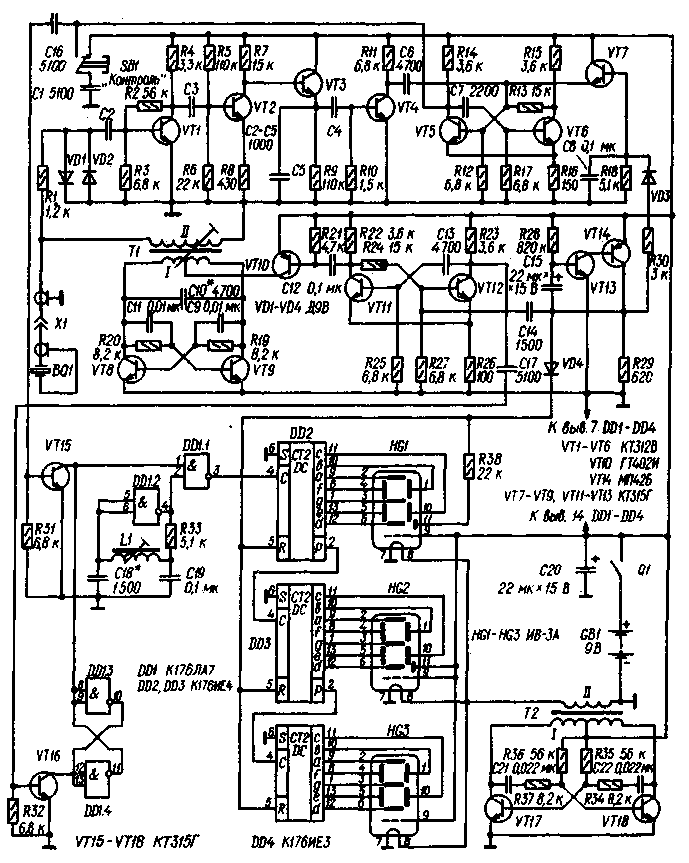
The block diagram illustrating the device and operation of the sonic depth finder is depicted in Figure 1. The clock generator G1 facilitates the interaction of the device's components, enabling automatic functionality. It generates short rectangular pulses of positive polarity with a duration of 0.1 seconds, repeating every 10 seconds. The leading edge of these pulses resets the digital counter PC1 to zero and temporarily disables the A2 receiver, allowing it to ignore signals during the transmitter's operation. Upon the arrival of the clock pulse, the A1 transmitter is activated, and the radiator sensor BQ1 emits a short ultrasonic probing pulse directed downward, lasting 40 microseconds. Simultaneously, the electronic switch S1 is activated, allowing a frequency of 7500 Hz from the G2 generator to reach the digital counter PC1. Once the transmitter ceases operation, the A2 receiver becomes active again and regains its normal sensitivity. The echo signal reflected from the bottom is captured by the BQ1 sensor and, after amplification in the receiver, triggers the closure of switch S1. The measurement is then completed, and the indicators on the PC1 counter display the measured depth. The next clock pulse resets the PC1 counter to zero, and the process begins anew. The schematic diagram of the sonic depth finder, which has a maximum measurement depth of 59.9 meters, is illustrated in Figure 2. The transmitter consists of a dual generator using transistors VT8 and VT9, with transformer T1 tuned to the operational frequency. Positive feedback required for self-excitation of the generator is provided by resistors R19 and R20 in conjunction with capacitors C9 and C11. The generator produces pulses with a duration of 40 microseconds and a radio-frequency component. The transmitter's modulator, composed of a monostable multivibrator using transistors VT11 and VT12, generates modulating pulses of 40 microseconds, while the amplifier is implemented using transistor VT10. The modulator remains in standby mode, receiving clock pulses through capacitor C14. The receiver of the sonic depth finder is designed for direct amplification. Transistors VT1 and VT2 amplify the signals received by the radiator sensor BQ1, while transistor VT3 functions as a peak detector, and transistor VT4 amplifies the detected signal. Transistors VT5 and VT6 form a monostable multivibrator that stabilizes the target pulse parameters and the receiver's sensitivity threshold. A diode limiter (VD1 and VD2) and resistor R1 protect the receiver from transmitter pulses. The receiver features a compulsory disabling mechanism for the monostable multivibrator via transistor VT7. A positive clock pulse is applied to the base of VT7 through diode VD3, charging capacitor C8. When activated, transistor VT7 connects the base of VT5 to the positive supply, preventing the multivibrator from responding to incoming pulses. After the clock pulse ends, capacitor C8 discharges through resistor R18, allowing transistor VT7 to gradually turn off, thus restoring normal sensitivity to the receiver's monostable multivibrator. The digital section of the sonic depth finder is constructed using chips DD1 to DD4. This section includes a key on element DD1.1, controlled by an RS flip-flop made from elements DD1.3 and DD1.4. The counting process begins with a pulse from the transmitter modulator through transistor VT16, while termination signals come from the receiver via transistor VT15. The pulse generator operating at a reference frequency of 7500 Hz is implemented using element DD1.2. The negative feedback loop, which stabilizes the element on a linear portion of its characteristic, consists of resistor R33 and inductor L1, enabling self-excitation at a frequency determined by the L1-C18 circuit parameters. The generator is finely tuned to the specified frequency.The block diagram explaining the device and operation of the sonic depth finder, is shown on fig. 1. The clock G1 generator operates interaction of knots of the device and provides its work in an automatic mode. Generated by it short (0, 1 c) rectangular impulses of positive polarity repeat each 10 pages. The front these impulses establish the digi tal PC1 counter in a zero condition and close the A2 receiver, doing it tolerant to signals on transmitter operating time. Recession the clock impulse starts the A1 transmitter, and the radiator sensor of BQ1 radiates in the bottom direction short (40 microsec) an ultrasonic probing impulse.
The electronic key of S1 at the same time opens, and fluctuations of exemplary frequency of 7500 Hz from the G2 generator arrive on the digital PC1 counter. Upon termination of operation of the transmitter the A2 receiver opens and gains normal sensitivity. Ekhosignal reflected from a bottom, is accepted by the BQ1 sensor and after strengthening in the receiver closes S1 key.
Measurement is finished, and indicators of the PC1 counter highlight the measured depth. The next clock impulse transfers again the PC1 counter to a zero condition, and process repeats. the Schematic diagram of the sonic depth finder with a limit of measurement of depth to 59, 9 m is represented by p on fig. 2. Its transmitter represents the duple generator on transistors VT8, VT9 with the T1 transformer adjusted on working frequency.
Necessary for generator self-excitation positive feedback is created by R19C9 and R20C11 chains. ` The generator forms impulses duration of 40 microsec with radio-frequency filling. Operation of the transmitter the modulator consisting of the one-vibrator on transistors VT11, VT12, forming modulating impulse duration of 40 microsec, and the amplifier on the VT10 transistor operates. The modulator works in the waiting mode, starting clock impulses arrive via the C14 condenser. the Receiver of the sonic depth finder is accurate according to the circuit of direct strengthening. Transistors VT1, VT2 strengthen BQ1 accepted by a radiator sensor … ³ ½ ° », the VT3 transistor is used and the peak detector, the VT4 transistor strengthens the pro-detected signal.
On transistors VT5, VT6 the one-vibrator providing constancy of parameters of target impulses and a threshold of sensitivity of the receiver is accurate. From a transmitter impulse the receiver protect the diode limiter (VD1, VD2) and the R1 resistor. In the receiver is applied by p compulsory switching off of the one-vibrator of the receiver by means of the VT7 transistor.
On its base via the VD3 diode the positive clock impulse arrives and charges the C8 condenser. Opening, the VT7 transistor connects base of the VT5 transistor of the one-vibrator of the receiver to a positive wire of a food, preventing thereby possibility of its operation from coming impulses. Upon termination of a clock impulse the C8 condenser is discharged via the R18 resistor, the VT7 transistor is gradually closed, and the one-vibrator of the receiver finds normal sensitivity.
The digital part of the sonic depth finder is collected on DD1-DD4 chips. Its structure includes a key on the element DD1. 1, operated by the RS trigger on the elements DD1. 3, DD1. 4. The impulse of the beginning of the account arrives on the trigger from the transmitter modulator via the VT16 transistor, the terminations - from a receiver exit via the VT15 transistor. the Generator of impulses with exemplary frequency of repetition (7500 Hz) is accurate on the element DD1.
2. The chain of the negative feedback deducing an element on a linear site of the characteristic is made of the R33 resistor and the L1 coil. It creates conditions for self-excitation on the frequency defined by parameters of a contour of L1C18.
Precisely on the set frequency the generator adjust a podstroyechnik of the coil. the Signal of exemplary frequency 🔗 External reference
The electronic key of S1 at the same time opens, and fluctuations of exemplary frequency of 7500 Hz from the G2 generator arrive on the digital PC1 counter. Upon termination of operation of the transmitter the A2 receiver opens and gains normal sensitivity. Ekhosignal reflected from a bottom, is accepted by the BQ1 sensor and after strengthening in the receiver closes S1 key.
Measurement is finished, and indicators of the PC1 counter highlight the measured depth. The next clock impulse transfers again the PC1 counter to a zero condition, and process repeats. the Schematic diagram of the sonic depth finder with a limit of measurement of depth to 59, 9 m is represented by p on fig. 2. Its transmitter represents the duple generator on transistors VT8, VT9 with the T1 transformer adjusted on working frequency.
Necessary for generator self-excitation positive feedback is created by R19C9 and R20C11 chains. ` The generator forms impulses duration of 40 microsec with radio-frequency filling. Operation of the transmitter the modulator consisting of the one-vibrator on transistors VT11, VT12, forming modulating impulse duration of 40 microsec, and the amplifier on the VT10 transistor operates. The modulator works in the waiting mode, starting clock impulses arrive via the C14 condenser. the Receiver of the sonic depth finder is accurate according to the circuit of direct strengthening. Transistors VT1, VT2 strengthen BQ1 accepted by a radiator sensor … ³ ½ ° », the VT3 transistor is used and the peak detector, the VT4 transistor strengthens the pro-detected signal.
On transistors VT5, VT6 the one-vibrator providing constancy of parameters of target impulses and a threshold of sensitivity of the receiver is accurate. From a transmitter impulse the receiver protect the diode limiter (VD1, VD2) and the R1 resistor. In the receiver is applied by p compulsory switching off of the one-vibrator of the receiver by means of the VT7 transistor.
On its base via the VD3 diode the positive clock impulse arrives and charges the C8 condenser. Opening, the VT7 transistor connects base of the VT5 transistor of the one-vibrator of the receiver to a positive wire of a food, preventing thereby possibility of its operation from coming impulses. Upon termination of a clock impulse the C8 condenser is discharged via the R18 resistor, the VT7 transistor is gradually closed, and the one-vibrator of the receiver finds normal sensitivity.
The digital part of the sonic depth finder is collected on DD1-DD4 chips. Its structure includes a key on the element DD1. 1, operated by the RS trigger on the elements DD1. 3, DD1. 4. The impulse of the beginning of the account arrives on the trigger from the transmitter modulator via the VT16 transistor, the terminations - from a receiver exit via the VT15 transistor. the Generator of impulses with exemplary frequency of repetition (7500 Hz) is accurate on the element DD1.
2. The chain of the negative feedback deducing an element on a linear site of the characteristic is made of the R33 resistor and the L1 coil. It creates conditions for self-excitation on the frequency defined by parameters of a contour of L1C18.
Precisely on the set frequency the generator adjust a podstroyechnik of the coil. the Signal of exemplary frequency 🔗 External reference
